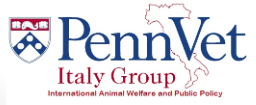 On the second to last day of our Public Health and Animal Welfare course at the IZS, we were lucky enough to have our afternoon lectures in the beautiful brown stone tower on the beach in Pineto.Our first lecturer was Paolo Dalla Villa, who spoke about the issue of stray dog and cat population control in times of natural disaster. He told us that on April 6, 2009, the L’Aquila region of Italy was hit by an earthquake measuring 5.8 on the Richter scale. 75,000 people were left homeless and forced to live in shelters in places like supermarket parking lots.
On the second to last day of our Public Health and Animal Welfare course at the IZS, we were lucky enough to have our afternoon lectures in the beautiful brown stone tower on the beach in Pineto.Our first lecturer was Paolo Dalla Villa, who spoke about the issue of stray dog and cat population control in times of natural disaster. He told us that on April 6, 2009, the L’Aquila region of Italy was hit by an earthquake measuring 5.8 on the Richter scale. 75,000 people were left homeless and forced to live in shelters in places like supermarket parking lots.

–This earthquake was the same disaster that destroyed the original restaurant of Gran Caffe L’Aquila, leading to the building of the new restaurant which recently opened on 17th and Chestnut in our own Philadelphia area.-
In addition, L’Aquila also faced the problem of stray pets which had been lost in the commotion and were now wandering the streets helplessly. IZS personnel stepped in to help, bringing with them a first-of-its-kind veterinary ambulance. This vehicle was used to rescue and assist lost, relinquished, or stray dogs and cats, so that they could be reunited with their owners if possible, or rehomed with new families.
In this effort to improve the health of these animals and better manage the dog and cat population, the IZS and veterinary aid workers found a huge cultural obstacle. When they offered free spaying and neutering of the rescued animals, only 170 out of over 700 animals underwent the procedure. This demonstrates the fact that citizens do not consider spaying and neutering a necessity for responsible pet ownership in Italy. In order to avoid creation of unwanted pets in the future, and particularly in times of natural disaster such as the earthquake, this cultural standard must be addressed.
Also vital to the rescue effort is the national identification and registration of companion animals. Though it is currently required by law for all dogs, owned and stray, to be microchipped and registered, the system is organized only regionally. This means that an abandoned or lost dog who is found in a region other than his home territory cannot be identified. Italy is currently working to develop a national registry to amend this problem, because identification of these animals is important for planning disease control programs and emergency response systems, and promotes responsible pet ownership by preventing pet abandonment.
Our next lecturer was Cesare Camma, who discussed identification of dogs using a DNA test based on various biological samples. Currently, the IZS is working on a technology in which they use characteristic pieces of DNA specific to each animal to identify individuals within a population. The project, funded by the Italian Ministry of Health, is able to use DNA from blood, feces, or a mouth swab to perform this task. The intention is for this identification system to be used in forensics, or for identifying and fining owners who do not clean up after their dogs during walks. In the United States, UC Davis is the leader in developing uses for this technology in animals.
The last lecturer of the day was Stefano Messori, who discussed other projects that are currently underway at the IZS. The first of these was Dog Tracker, a possible application of a free-roaming dog tracking device. In order to develop this, researchers collected data about stray dogs by driving around different regions of Italy and locating these animals from their cars. From this data, researchers will be better able to extrapolate the number of free-roaming dogs in Italy, a value which had only been roughly estimated in the past.
Another project that Stefano described was one investigating whether transportation stress, which is known to negatively impact the welfare of livestock animals, also applies to dogs being moved from one place to another. This stress could potentially occur during trading of dogs among EU countries; 123,000 such animals were traded in the year 2012. Because transportation stress is a major risk factor for the spread of disease, in that it can make latent infections reoccur, it is important to quantify the stress experienced by dogs during transportation to protect the health of the dog and human populations alike.
Lastly, Stefano told us about an innovative project that IZS researchers were developing in order to more accurately assess the welfare of shelter dogs. Welfare has been assessed only by human observers in the past, making this wok very subjective, labor-intensive, and time-consuming. The IZS’s solution to this problem involves video analysis of dog behavior. A new software has been developed, using technology akin to that used in the Xbox Live system, which identifies a dog and tracks its movement 24/7 in the shelter. The software is able to identify different stances and movements, including standing, sitting, lying, and jumping up. This can be used to assess the dog’s normal behavior, and identify any abnormalities or anxiety in the shelter environment.
Hearing about these new innovations for animal welfare and public health was extremely interesting, because we had not previously been introduced to these projects. We are very excited to see how these efforts impact these fields of study in the future.
